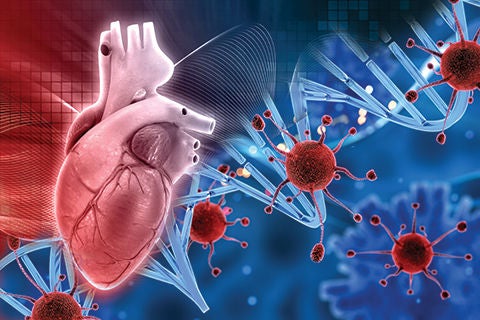
Early detection and advances in cancer treatment have significantly improved the clinical outcomes of patients; enabling cancer patients to survive and live beyond their initial diagnosis. However, these patients face a higher risk of cardiac complications.
About 5 million adult patients with cancer suffered from pre-existing or incident cardiovascular disease worldwide, with Asia accounting for 50% of global cancer burden1,2. Research has shown that cancer patients are at higher risk of dying from heart disease and stroke3. Cardiovascular disease and cancer also have common risk factors that can lead to increased cardiac disease burden in patients with cancer. There have been many research studies on the long-term cardiovascular side effects of cancer treatments, also known as cardiotoxicities.
Dr Chong Jun Hua, Consultant from the Department of Cardiology at NHCS, is the first cardiologist in Asia to be board-certified in cardio-oncology from the International Cardio-Oncology Society. In this issue, she shares more about cardio-oncology - an emerging cardiology subspecialty that investigates cardiac complications of cancer and cancer therapy.
Q: What kind of patients are usually referred for cardio-oncology review?
A: Patients with primary and secondary cardiac tumours, and those suffering from cardiac complications of breast or other tumours, and blood cancer are usually referred to us by oncologists or haematologists across various cancer centres and hospitals in Singapore.
In NHCS, we see about an average of 30 new cardio-oncology referrals each month, of which about 50% of the referrals are from breast cancer while the remaining from blood cancer and immunotherapyrelated cardiotoxicity. Around 10% of all breast cancer patients will experience cardiotoxicity secondary to cancer therapy, and can be referred for cardio-oncology review. Breast cancer patients on potentially cardiotoxic medications are also referred to the echocardiography service for screening and surveillance. As more novel therapies in cancer are developed, the range of cardiooncology presentations will become more diversified.
Q: What are the common cardiac complications?
A: The complications from cancer therapy are diverse. Most commonly, patients may develop left ventricular dysfunction (a condition where the left ventricle of the heart – which main function is to pump blood to the rest of the body - is damaged) from anthracyclines, a common drug used in cancer chemotherapy. Other complications include therapy-induced hypertension, myocarditis (inflammation of the heart muscle), coronary artery spasm or heart rhythm abnormalities, and radiotherapy-induced coronary artery calcification (calcium build-up). Patients may also develop other cardiopulmonaryrelated complications such as pulmonary hypertension, pulmonary or systemic embolism (blockage in artery) and loss of cardiorespiratory fitness (body’s ability to supply oxygen to the muscles during physical activity).
Q: How is treating this group of patients different from the typical cardiac patients?
A: Patients with co-existing cancer may be less tolerant of cardiac medication side-effects. The time course of disease may also be different. For instance, they may develop sudden deterioration from radiation-induced coronary artery disease many years after exposure. The cardiac complications may also be less predictable as newer cancer therapy agents are prescribed. It is thus vital for cardiologists to keep abreast of the latest literature and evidence in the cancer field so that they are aware of the various cardiac complications to look out for.
Q: Are there specific care or strategies to help control the cardiac complications?
A: Cardio-oncology patients are in many ways at the crossroads of the various cardiology subspecialties and diagnostics, and hence multidisciplinary teams are involved to better manage the treatment for these patients. Early clinical suspicion and screening will help in early detection of subclinical cardiac diseases (asymptomatic or mild symptoms). Most importantly, patients must make major lifestyle changes to control and minimise key cardiovascular risk factors such as high blood pressure, high cholesterol, diabetes, obesity and smoking.
1 Youn J-C, Chung W-B, Ezekowitz JA, Hong JH, Nam H, Kyoung D-S, et al. Cardiovascular disease burden in adult patients with cancer: An 11-year nationwide population-based cohort study. Int J Cardiol. 2020 Oct;317:167–73.
2 World Cancer Research Fund. Worldwide cancer data [Internet]. [cited 2021 Oct 23]. Available from: https://www.wcrf.org/dietandcancer/worldwide-cancer-data
3 Zhang X, Pawlikowski M, Olivo-Marston S, Williams KP, Bower JK, Felix AS (2021) Ten-year cardiovascular risk among cancer survivors: The National Health and Nutrition Examination Survey. PLoS ONE 16(3): e0247919. https://doi.org/10.1371/journal.pone.0247919
This article is from Murmurs Issue 40 (May – August 2021). Click here to read the full issue.













 Get it on Google Play
Get it on Google Play